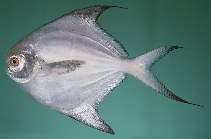Ajouter votre observation dans Fish Watcher
| Native range | All suitable habitat | Point map | Year 2050 |

|
| This map was computer-generated and has not yet been reviewed. |
| Pampus argenteus AquaMaps Data sources: GBIF OBIS |
Envoyez vos Photos et vidéos
Pictures | Stamps, coins, misc. | Images GooglePampus argenteus
Picture by Randall, J.E.
Pictures | Stamps, coins, misc. | Images GooglePampus argenteus
Picture by Randall, J.E.
Common names from other countries
Classification / Names Noms communs | Synonymes | Catalog of Fishes(Genre, Espèce) | ITIS | CoL | WoRMS | Cloffa
Issue
Pampus cinereus is considered a valid species according to Liu et al., 2013 (Ref. 95516) and P. liuorum Liu & Li, 2013 (Ref. 95101) is a junior synonym of Pampus cinereus according to Yin et al., 2019 (Ref. 123875).
Environment: milieu / climate zone / depth range / distribution range Écologie
marin benthopélagique; océanodrome (Ref. 51243); profondeur 5 - 110 m (Ref. 12260). Subtropical; 46°N - 10°S, 47°E - 142°E
Distribution Pays | Zones FAO | Écosystèmes | Occurrences | Point map | Introductions | Faunafri
Indo-West Pacific: Persian Gulf to Indonesia, north to Hokkaido, Japan. Extralimital captures have been made from the Adriatic and off Hawaii. Not recorded from Australasia. Northeastern Atlantic: 3 reports of capture reported from this area (Ref. 86350).
Length at first maturity / Taille / Poids / Âge
Maturity: Lm 25.3, range 18 - ? cm
Max length : 60.0 cm SL mâle / non sexé; (Ref. 9811); common length : 30.0 cm SL mâle / non sexé; (Ref. 9811); âge max. reporté: 7 années (Ref. 45538)
Max length : 60.0 cm SL mâle / non sexé; (Ref. 9811); common length : 30.0 cm SL mâle / non sexé; (Ref. 9811); âge max. reporté: 7 années (Ref. 45538)
Description synthétique Clés d'identification | Morphologie | Morphométrie
Épines dorsales (Total) : 0; Rayons mous dorsaux (Total) : 37 - 43; Vertèbres: 34 - 37. Body firm, very deep, oval, and compressed. Operculum absent; gill opening reduced to a vertical slit on the side of the body; gill membrane broadly united to isthmus. Dorsal and anal fins preceded by a series of 5 to 10 blade-like spines with anterior and posterior points. Pelvic fins absent. Caudal fin deeply forked, the lower lobe longer than the upper. Color is gray above grading to silvery white towards the belly, with small black dots all over the body. Fins are faintly yellow; vertical fins with dark edges.
Inshore species, usually in schools over muddy bottoms, associated with fish species like Nemipterus and Leiognathus. Adults feed on ctenophores, salps, medusae, and other zooplankton groups. Western populations spawn from late winter through the summer with peaks from April to June. Sold fresh in local markets or shipped frozen to urban centers. Used in Chinese medicine (Ref. 12166).
Life cycle and mating behavior Maturité | Reproduction | Frai | Œufs | Fécondité | Larves
Référence principale
Upload your references | Références | Coordinateur | Collaborateurs
Haedrich, R.L., 1984. Stromateidae. In W. Fischer and G. Bianchi (eds.) FAO species identification sheets for fishery purposes. Western Indian Ocean (Fishing Area 51). Vol. 4. FAO, Rome. pag. var. (Ref. 3517)
Menace pour l'homme
Harmless
Utilisations par l'homme
Pêcheries: hautement commercial
FAO(pêcheries: production; publication : search) | FishSource | Sea Around Us
Plus d'informations
Trophic ecology
Éléments du régime alimentaire
Composition du régime alimentaire
Consommation alimentaire
Food rations
Prédateurs
Éléments du régime alimentaire
Composition du régime alimentaire
Consommation alimentaire
Food rations
Prédateurs
Population dynamics
Paramètres de croissance
Max. ages / sizes
Length-weight rel.
Length-length rel.
Fréquences de longueurs
Mass conversion
Recrutement
Abondance
Paramètres de croissance
Max. ages / sizes
Length-weight rel.
Length-length rel.
Fréquences de longueurs
Mass conversion
Recrutement
Abondance
Anatomy
Surface branchiale
Brain
Otolith
Surface branchiale
Brain
Otolith
Physiology
Body composition
Nutrients
Consommation d'oxygène
Type de nage
Vitesse de nage
Visual pigments
Fish sound
Diseases & Parasites
Toxicity (LC50s)
Body composition
Nutrients
Consommation d'oxygène
Type de nage
Vitesse de nage
Visual pigments
Fish sound
Diseases & Parasites
Toxicity (LC50s)
Genetics
Génétique
Heterozygosity
Héritabilité
Génétique
Heterozygosity
Héritabilité
Human related
Aquaculture systems
Profils d'aquaculture
Souches
Ciguatera cases
Stamps, coins, misc.
Aquaculture systems
Profils d'aquaculture
Souches
Ciguatera cases
Stamps, coins, misc.
Outils
E-book | Guide de terrain | Clés d'identification | Générateur de fréquences de longueur | Outil de dynamique de population | Carte par point | Classification Tree
| Catch-MSY |
Articles particuliers
Télécharger en XML
Sources Internet
Aquatic Commons | BHL | Cloffa | BOLDSystems | Websites from users | FishWatcher | CISTI | Catalog of Fishes(Genre, Espèce) | DiscoverLife | ECOTOX | Faunafri | Fishtrace | GenBank(génôme, nucléotide) | GloBI | GOBASE | | Google Books | Google Scholar | Google | IGFA World Record | MitoFish | Bases de données nationales | Otolith Atlas of Taiwan Fishes | PubMed | Reef Life Survey | Identification RFE | Scirus | SeaLifeBase | Arbre de Vie | Wikipedia(aller à, chercher) | World Records Freshwater Fishing | Zoological Record
Estimates based on models
Preferred temperature (Ref. 115969): 21.9 - 29.1, mean 28.1 (based on 1636 cells).
Phylogenetic diversity index (Ref. 82804): PD50 = 0.5313 [Uniqueness, from 0.5 = low to 2.0 = high].
Bayesian length-weight: a=0.01820 (0.01405 - 0.02357), b=3.02 (2.95 - 3.09), in cm Total Length, based on LWR estimates for this species (Ref. 93245).
Niveau trophique (Ref. 69278): 3.3 ±0.1 se; based on diet studies.
Résilience (Ref. 120179): Milieu, temps minimum de doublement de population : 1,4 à 4,4 années (K=0.24-0.26; tmax=7; Fec=5,470).
Prior r = 0.57, 95% CL = 0.37 - 0.85, Based on 9 data-limited stock assessments.
Fishing Vulnerability (Ref. 59153): Low to moderate vulnerability (31 of 100).
Climate Vulnerability (Ref. 125649): Moderate to high vulnerability (48 of 100).




